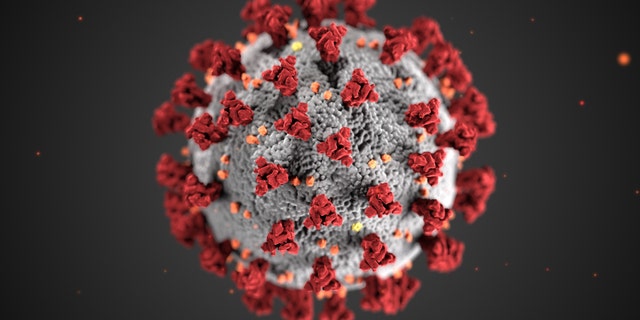What are the coronavirus transmission risks?

WHO, Fauci at odds over asymptomatic transmission of coronavirus
Fox News medical correspondent Dr. Marc Siegel explains what dangers asymptomatic people pose.
The coronavirus presents various transmission risks, depending on where people are, how close they are in proximity to others, or what type of protection is used to limit potential exposure from the virus.
Researchers and health experts have said the virus can stay in the air for an extended period of time, spread from person to person within close distances, and even remain some types of surfaces for days.
So what are the coronavirus transmission risks?
COVID-19 is mainly thought to spread via larger droplet particles that are expelled when an infected person talks or breaths, according to the World Health Organization (WHO). Those droplets settle more quickly are less likely to accumulate in the air, with masks serving as an effective barrier.

COVID-19 Coronavirus molecule, March 24, 2020.
(Photo by CDC/API/Gamma-Rapho via Getty Images)
NEW CORONAVIRUS MAP SHOWS MORE THAN HALF OF ALL STATES ARE 'TRENDING POORLY' OR HAVE 'UNCONTROLLED SPREAD'
The WHO says those droplets present the greatest risk to people, however, hundreds of researchers recently signed an open letter to the organization requesting it pay more attention to tiny aerosol droplets, which they believe may be an additional method of coronavirus transmission. Those smaller particles are expelled when breathing, speaking, coughing, or sneezing and can linger in the air for much longer.
"Most public health organizations, including the WHO, do not recognize airborne transmission except for aerosol-generating procedures performed in healthcare settings," the letter states, "Hand-washing and social distancing are appropriate, but in our view, insufficient to provide protection from virus-carrying respiratory microdroplets released into the air by infected people."
In terms of aerosol particles presenting a transmission risk, a report in the New England Journal of Medicine (NEJM) found they can linger in the air for up to three hours, which potentially makes enclosed areas with limited airflow more dangerous. A CDC report also found the virus can travel at least 13 feet by those aerosols, which is more than twice as far as the recommended social distancing guidelines. Even with the aerosols potentially reaching further, social distancing and staying outdoors are seen as ways to limit exposure to the particles.
“Studies in laboratory conditions now show the virus stays alive in aerosol form with a half-life on the scale of hours. It persists in the air,” said William Ristenpart, a professor of chemical engineering at UC Davis. “That’s why you want to be outdoors for any social situations if possible. The good airflow will disperse the virus. If you are indoors, think about opening the windows. You want as much fresh air as possible.”
EX-HARVARD MEDICAL SCHOOL FACULTY MEMBER WARNS COVID-19 HERD IMMUNITY IS 'WISHFUL THINKING'
Surfaces are also a potential risk of COVID-19 transmission, with the CDC arguing that "it may be possible that a person can get COVID-19 by touching a surface or object that has the virus on it and then touching their own mouth, nose, or possibly their eyes."
Studies by the Lancet and the NEJM found the virus was detected on printing and tissue paper for up to three hours, cardboard for up to 24 hours, up to two days on wood and cloth fabric, and up to seven days on plastic and stainless steel. Meanwhile, it lasted up to 4 days on paper money and glass.
There are also risks of contracting the virus from people who aren't showing symptoms. A WHO official last week stated that coronavirus transmission by asymptomatic individuals was "very rare," which drew criticism from America’s leading infectious disease expert Dr. Anthony Fauci.
CLICK HERE FOR THE FOX NEWS APP
“We know from epidemiological studies they can transmit to someone who is uninfected even when they're without symptoms," Fauci, the director of the National Institute of Allergy and Infectious Diseases, told ABC’s “Good Morning America” last Wednesday. "So to make a statement to say that's a rare event was not correct."
Fox News’ Madeline Farber contributed to this report
Source: Read Full Article


